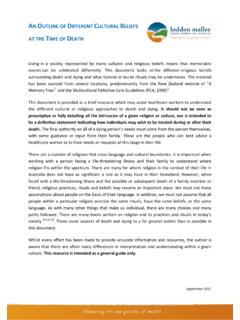Transcription of Palliative and end of life care guidelines
1 Palliative and end of life careguidelinesfor cancer and non-cancer patientsThird edition: 2012 North of EnglandCancer NetworkNORTH OF ENGLAND CANCER NETWORK Palliative care GUIDELINESNORTH OF ENGLAND CANCER NETWORK Palliative AND END OF life care GUIDELINESFOREWORDT hese guidelines have been written for clinical staff who provide Palliative and end of life care topatients within their usual role this work is often referred to as generalist Palliative care . Theguidelines do not attempt to cover specialist Palliative care for which much more comprehensivetexts and resources hope that this concise guideline booklet will provide clear and accessible information for use inthe patient s home, in the surgery and on the 3rd edition has been redrafted and updated by wide consultation across the Network,including partners in regional groups beyond Palliative care .
2 The result is content that, as far aspossible, represents a consensus informed by available evidence. It is in the nature of the specialtythat research in some areas is limited and much established practice is based upon evolving expertopinion and expanding clinical , the guideline information is relevant to all Palliative care patients regardless ofdiagnosis. Where specific guidance applies, this is highlighted in the use of drugs beyond licence ( off-label ) in Palliative care and pain management practice iscurrently both necessary and common and should be seen as a legitimate aspect of clinical practice.
3 (APM/BPS 2008) guidelines are a place to begin. They cannot replace specialist advice from experienced to the practice of Palliative care is an emphasis on individualised care for the symptoms fail to respond to usual measures, or if you are concerned that the recommendationsgiven here may not be appropriate to the clinical situation, please contact your local specialistpalliative care team. Contact numbers are listed on the final pages of this are due to all who have contributed to the development of these contributors hope you find these guidelines both clear and helpful, to the benefit of thepatients in your care and to your own practice.
4 Observations or comments which may informfuture review of this booklet are welcome and should be directed to the NECN Alison FeatherstoneNECN Palliative care Clinical LeadDr Alex Nicholson FRCPC onsultant in Palliative Medicine1 NORTH OF ENGLAND CANCER NETWORK Palliative care GUIDELINESNORTH EAST CANCER NETWORK Palliative AND END OF life care GUIDELINESIMPORTANT NOTE:The most significant change in this revised edition is that MORPHINE is the recommended firstline subcutaneous opioid, replacing applies for doses of subcutaneous morphine up to 360mg/24hrs.
5 If the calculated subcutaneous morphine dose requirement exceeds 360mg/24hrs it will benecessary to switch to an alternative opioid because of resulting volume constraints in therescue dose. You should seek specialist advice in this further information see pages 5 to care .. 2 Pain .. 3 Using Opioids for Pain in Palliative care .. 5 Constipation .. 10 Nausea and Vomiting .. 12 Corticosteroids in Palliative care .. 14 Control of Glucose in Patients on Corticosteroids .. 15 Depression and Anxiety .. 16 Emergencies Metastatic Spinal Cord Compression (MSCC).
6 18 Emergencies Malignant Hypercalcaemia .. 19 Emergencies Major Haemorrhage ..20 Emergencies Malignant Superior Vena Cava Obstruction .. 21 Diabetes Management at the End of life .. 22 Pain at the End of life .. 23 Pain at the End of life in Renal Failure .. 24 Pain at the End of life Supplementary Information .. 25 Nausea and/or Vomiting at the End of life ..26 Restlessness and/or Agitation at the End of life .. 27 Respiratory Tract Secretions at the End of life ..28 Breathlessness at the End of life .
7 29 Breathlessness at the End of life in Renal Failure .. 30 Specialist Palliative care Services Contact Details ..31 Additional References .. 32 For the most part, dose guidance included in these guidelines is in line with the British National Formulary(BNF). Where the guidance differs and follows the Palliative care Formulary 4th Edition (PCF4), this ishighlighted in the RESOURCES(further references are listed on the final page)Dickman A. (2011) The syringe driver. Oxford University Press, OxfordRegnard C & Dean M.
8 (2010) A guide to symptom relief in Palliative care . 6th edition. Radcliffe Press, R, Wilcock A (2011) Palliative care Formulary. 4th Edition. Ltd., M, Lucas C, Hoy A & Back I. (2005) Oxford Handbook of Palliative care . Oxford University Press, 62 (September 2011) BMJ Group and Pharmaceutical Press, CAREThe WHO defines Palliative care as: the active, holistic care of patients with advanced, progressive illness. Management of pain andother symptoms and provision of psychological, social and spiritual support is paramount.
9 Thegoal of Palliative care is achievement of the best quality of life for patients and their families. The principles of Palliative care are relevant to patients with both malignant and non-malignantdisease and may be relevant to patients early in their disease trajectory. Therefore the principles ofpalliative care should not be applied solely to cancer patients at the end of life . The commonest symptoms include:PainAnxietyFatigueBreathlessness NauseaVomiting Diarrhoea DepressionConfusion AnorexiaInsomniaConstipationKey principles of symptom managementSeveral principles are fundamental to the Palliative care approach.
10 Conduct a detailed assessment in partnership with patient and carers Diagnose cause of symptom(s) using knowledge of pathophysiology and disease processes Choose appropriate treatment for the individual balancing benefit against side effect burdenand considering factors such as route of administration Avoid making too many changes at once or review will be complex Constantly reassess: review, review, review Anticipate future problems and plan ahead as much as guideline booklet does not address every symptom and it is not the intention of the booklet toreplace the excellent handbooks of Palliative care and symptom control which exist.


